wheel NISSAN QASHQAI 2017 Owner´s Manual
[x] Cancel search | Manufacturer: NISSAN, Model Year: 2017, Model line: QASHQAI, Model: NISSAN QASHQAI 2017Pages: 508, PDF Size: 2.68 MB
Page 12 of 508
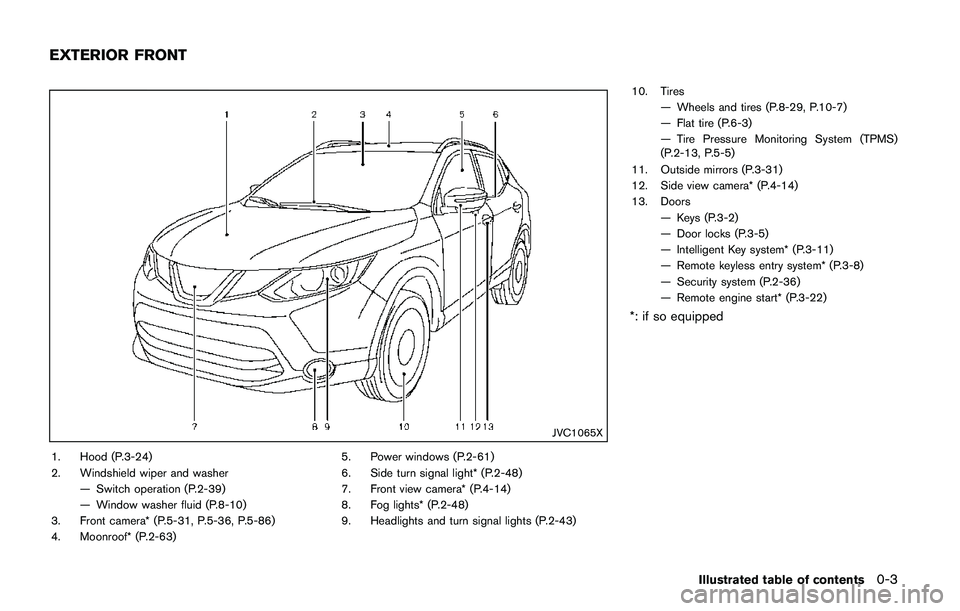
JVC1065X
1. Hood (P.3-24)
2. Windshield wiper and washer
— Switch operation (P.2-39)
— Window washer fluid (P.8-10)
3. Front camera* (P.5-31, P.5-36, P.5-86)
4. Moonroof* (P.2-63)5. Power windows (P.2-61)
6. Side turn signal light* (P.2-48)
7. Front view camera* (P.4-14)
8. Fog lights* (P.2-48)
9. Headlights and turn signal lights (P.2-43)10. Tires
— Wheels and tires (P.8-29, P.10-7)
— Flat tire (P.6-3)
— Tire Pressure Monitoring System (TPMS)
(P.2-13, P.5-5)
11. Outside mirrors (P.3-31)
12. Side view camera* (P.4-14)
13. Doors
— Keys (P.3-2)
— Door locks (P.3-5)
— Intelligent Key system* (P.3-11)
— Remote keyless entry system* (P.3-8)
— Security system (P.2-36)
— Remote engine start* (P.3-22)
*: if so equipped
Illustrated table of contents0-3
EXTERIOR FRONT
Page 15 of 508
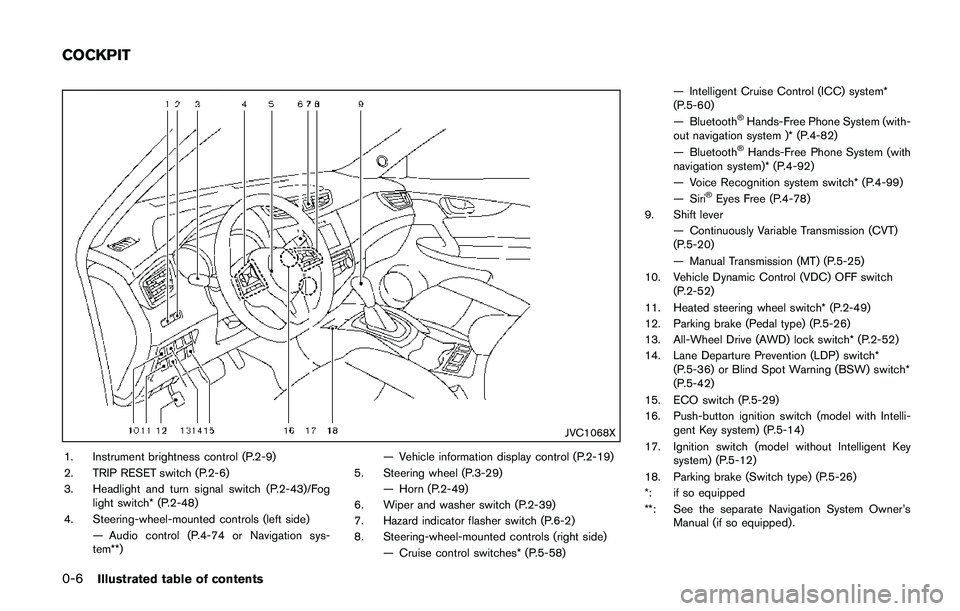
0-6Illustrated table of contents
JVC1068X
1. Instrument brightness control (P.2-9)
2. TRIP RESET switch (P.2-6)
3. Headlight and turn signal switch (P.2-43)/Fog
light switch* (P.2-48)
4. Steering-wheel-mounted controls (left side)
— Audio control (P.4-74 or Navigation sys-
tem**)— Vehicle information display control (P.2-19)
5. Steering wheel (P.3-29)
— Horn (P.2-49)
6. Wiper and washer switch (P.2-39)
7. Hazard indicator flasher switch (P.6-2)
8. Steering-wheel-mounted controls (right side)
— Cruise control switches* (P.5-58)— Intelligent Cruise Control (ICC) system*
(P.5-60)
— Bluetooth
�ŠHands-Free Phone System (with-
out navigation system )* (P.4-82)
— Bluetooth
�ŠHands-Free Phone System (with
navigation system)* (P.4-92)
— Voice Recognition system switch* (P.4-99)
— Siri
�ŠEyes Free (P.4-78)
9. Shift lever
— Continuously Variable Transmission (CVT)
(P.5-20)
— Manual Transmission (MT) (P.5-25)
10. Vehicle Dynamic Control (VDC) OFF switch
(P.2-52)
11. Heated steering wheel switch* (P.2-49)
12. Parking brake (Pedal type) (P.5-26)
13. All-Wheel Drive (AWD) lock switch* (P.2-52)
14. Lane Departure Prevention (LDP) switch*
(P.5-36) or Blind Spot Warning (BSW) switch*
(P.5-42)
15. ECO switch (P.5-29)
16. Push-button ignition switch (model with Intelli-
gent Key system) (P.5-14)
17. Ignition switch (model without Intelligent Key
system) (P.5-12)
18. Parking brake (Switch type) (P.5-26)
*: if so equipped
**: See the separate Navigation System Owner’s
Manual (if so equipped) .
COCKPIT
Page 16 of 508
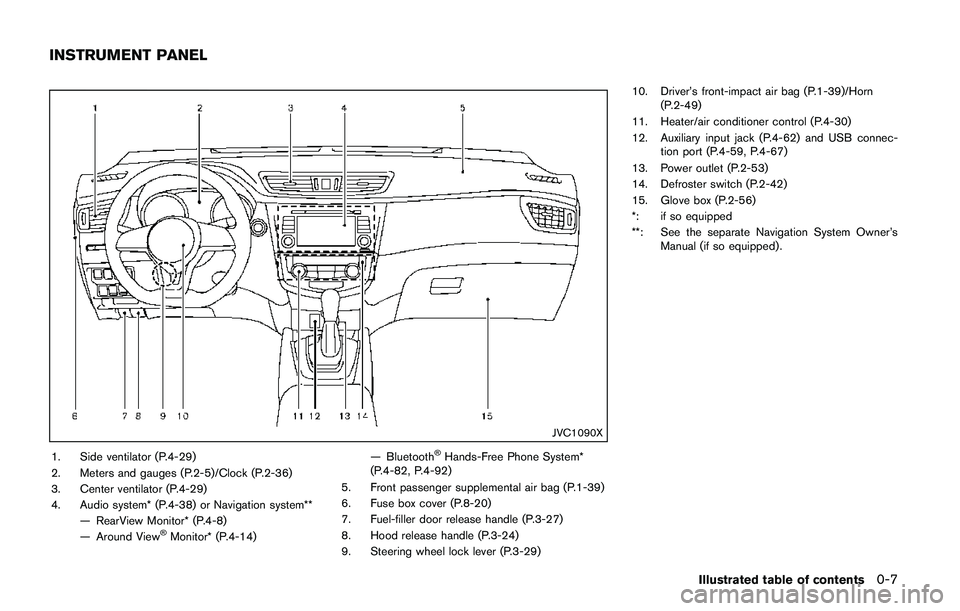
JVC1090X
1. Side ventilator (P.4-29)
2. Meters and gauges (P.2-5)/Clock (P.2-36)
3. Center ventilator (P.4-29)
4. Audio system* (P.4-38) or Navigation system**
— RearView Monitor* (P.4-8)
— Around View
�ŠMonitor* (P.4-14)— Bluetooth
�ŠHands-Free Phone System*
(P.4-82, P.4-92)
5. Front passenger supplemental air bag (P.1-39)
6. Fuse box cover (P.8-20)
7. Fuel-filler door release handle (P.3-27)
8. Hood release handle (P.3-24)
9. Steering wheel lock lever (P.3-29)10. Driver’s front-impact air bag (P.1-39)/Horn
(P.2-49)
11. Heater/air conditioner control (P.4-30)
12. Auxiliary input jack (P.4-62) and USB connec-
tion port (P.4-59, P.4-67)
13. Power outlet (P.2-53)
14. Defroster switch (P.2-42)
15. Glove box (P.2-56)
*: if so equipped
**: See the separate Navigation System Owner’s
Manual (if so equipped) .
Illustrated table of contents0-7
INSTRUMENT PANEL
Page 19 of 508
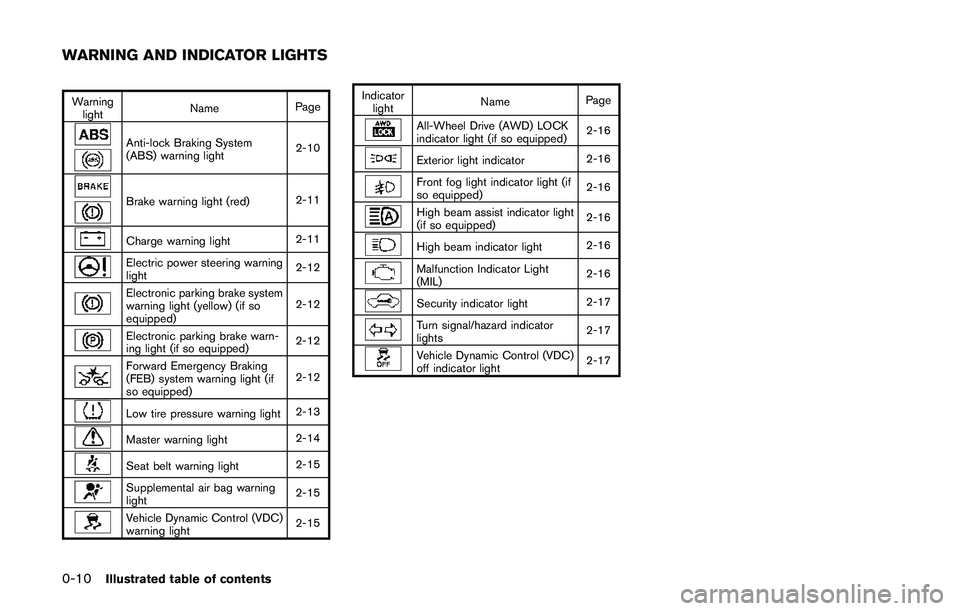
0-10Illustrated table of contents
Warning
lightNamePage
Anti-lock Braking System
(ABS) warning light2-10
Brake warning light (red)2-11
Charge warning light2-11
Electric power steering warning
light2-12
Electronic parking brake system
warning light (yellow) (if so
equipped)2-12
Electronic parking brake warn-
ing light (if so equipped)2-12
Forward Emergency Braking
(FEB) system warning light (if
so equipped)2-12
Low tire pressure warning light2-13
Master warning light2-14
Seat belt warning light2-15
Supplemental air bag warning
light2-15
Vehicle Dynamic Control (VDC)
warning light2-15Indicator
lightNamePage
All-Wheel Drive (AWD) LOCK
indicator light (if so equipped)2-16
Exterior light indicator2-16
Front fog light indicator light (if
so equipped)2-16
High beam assist indicator light
(if so equipped)2-16
High beam indicator light2-16
Malfunction Indicator Light
(MIL)2-16
Security indicator light2-17
Turn signal/hazard indicator
lights2-17
Vehicle Dynamic Control (VDC)
off indicator light2-17
WARNING AND INDICATOR LIGHTS
Page 58 of 508
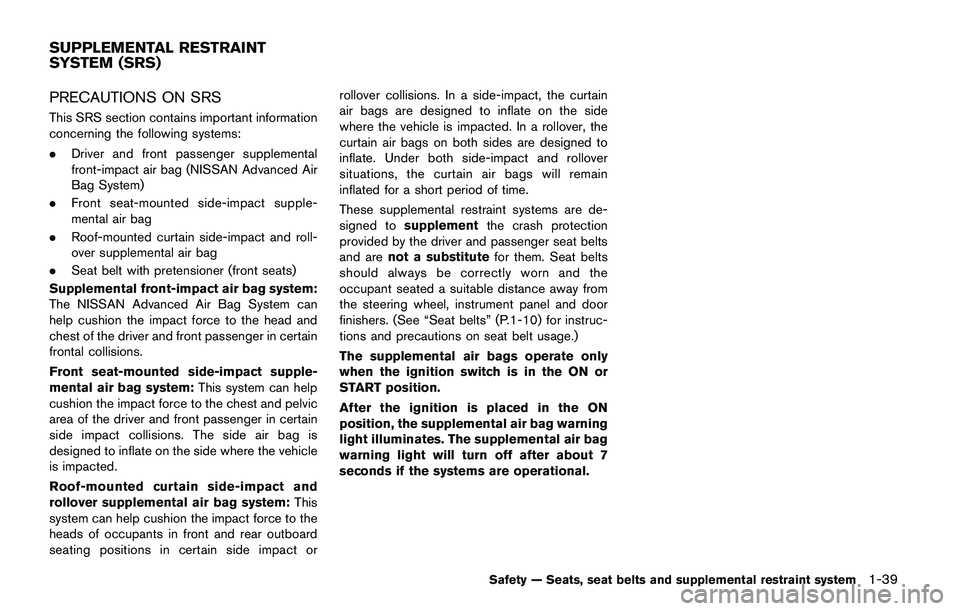
PRECAUTIONS ON SRS
This SRS section contains important information
concerning the following systems:
.Driver and front passenger supplemental
front-impact air bag (NISSAN Advanced Air
Bag System)
.Front seat-mounted side-impact supple-
mental air bag
.Roof-mounted curtain side-impact and roll-
over supplemental air bag
.Seat belt with pretensioner (front seats)
Supplemental front-impact air bag system:
The NISSAN Advanced Air Bag System can
help cushion the impact force to the head and
chest of the driver and front passenger in certain
frontal collisions.
Front seat-mounted side-impact supple-
mental air bag system:This system can help
cushion the impact force to the chest and pelvic
area of the driver and front passenger in certain
side impact collisions. The side air bag is
designed to inflate on the side where the vehicle
is impacted.
Roof-mounted curtain side-impact and
rollover supplemental air bag system:This
system can help cushion the impact force to the
heads of occupants in front and rear outboard
seating positions in certain side impact orrollover collisions. In a side-impact, the curtain
air bags are designed to inflate on the side
where the vehicle is impacted. In a rollover, the
curtain air bags on both sides are designed to
inflate. Under both side-impact and rollover
situations, the curtain air bags will remain
inflated for a short period of time.
These supplemental restraint systems are de-
signed tosupplementthe crash protection
provided by the driver and passenger seat belts
and arenot a substitutefor them. Seat belts
should always be correctly worn and the
occupant seated a suitable distance away from
the steering wheel, instrument panel and door
finishers. (See “Seat belts” (P.1-10) for instruc-
tions and precautions on seat belt usage.)
The supplemental air bags operate only
when the ignition switch is in the ON or
START position.
After the ignition is placed in the ON
position, the supplemental air bag warning
light illuminates. The supplemental air bag
warning light will turn off after about 7
seconds if the systems are operational.
Safety — Seats, seat belts and supplemental restraint system1-39
SUPPLEMENTAL RESTRAINT
SYSTEM (SRS)
Page 60 of 508
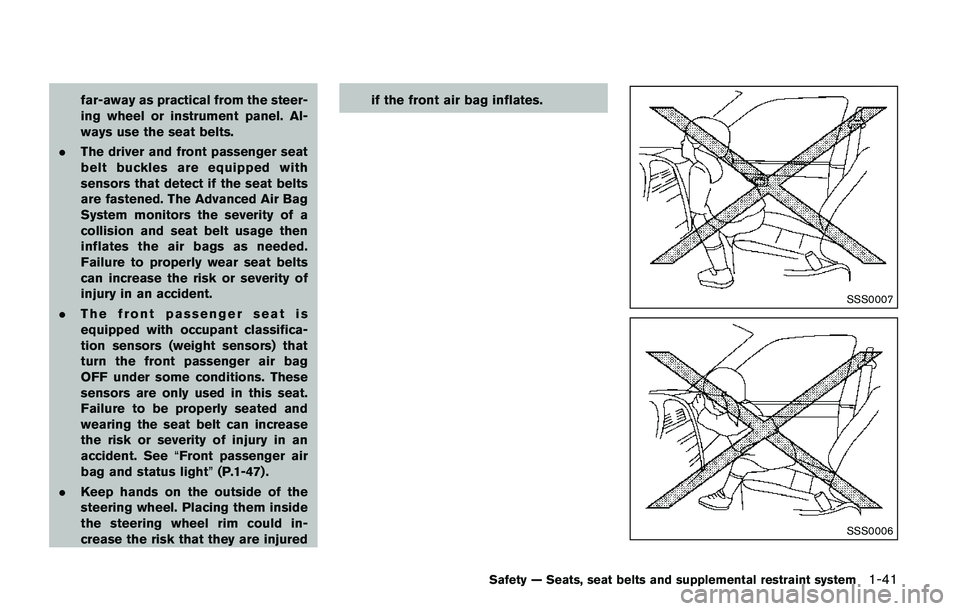
far-away as practical from the steer-
ing wheel or instrument panel. Al-
ways use the seat belts.
.The driver and front passenger seat
belt buckles are equipped with
sensors that detect if the seat belts
are fastened. The Advanced Air Bag
System monitors the severity of a
collision and seat belt usage then
inflates the air bags as needed.
Failure to properly wear seat belts
can increase the risk or severity of
injury in an accident.
.The front passenger seat is
equipped with occupant classifica-
tion sensors (weight sensors) that
turn the front passenger air bag
OFF under some conditions. These
sensors are only used in this seat.
Failure to be properly seated and
wearing the seat belt can increase
the risk or severity of injury in an
accident. See“Front passenger air
bag and status light”(P.1-47) .
.Keep hands on the outside of the
steering wheel. Placing them inside
the steering wheel rim could in-
crease the risk that they are injuredif the front air bag inflates.
SSS0007
SSS0006
Safety — Seats, seat belts and supplemental restraint system1-41
Page 65 of 508
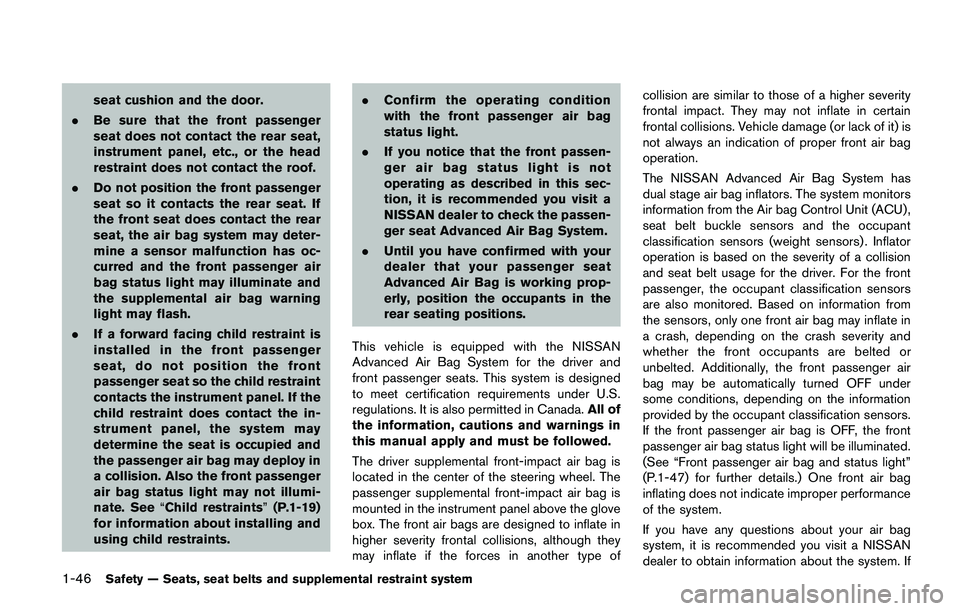
1-46Safety — Seats, seat belts and supplemental restraint system
seat cushion and the door.
.Be sure that the front passenger
seat does not contact the rear seat,
instrument panel, etc., or the head
restraint does not contact the roof.
.Do not position the front passenger
seat so it contacts the rear seat. If
the front seat does contact the rear
seat, the air bag system may deter-
mine a sensor malfunction has oc-
curred and the front passenger air
bag status light may illuminate and
the supplemental air bag warning
light may flash.
.If a forward facing child restraint is
installed in the front passenger
seat, do not position the front
passenger seat so the child restraint
contacts the instrument panel. If the
child restraint does contact the in-
strument panel, the system may
determine the seat is occupied and
the passenger air bag may deploy in
a collision. Also the front passenger
air bag status light may not illumi-
nate. See“Child restraints”(P.1-19)
for information about installing and
using child restraints..Confirm the operating condition
with the front passenger air bag
status light.
.If you notice that the front passen-
ger air bag status light is not
operating as described in this sec-
tion, it is recommended you visit a
NISSAN dealer to check the passen-
ger seat Advanced Air Bag System.
.Until you have confirmed with your
dealer that your passenger seat
Advanced Air Bag is working prop-
erly, position the occupants in the
rear seating positions.
This vehicle is equipped with the NISSAN
Advanced Air Bag System for the driver and
front passenger seats. This system is designed
to meet certification requirements under U.S.
regulations. It is also permitted in Canada.All of
the information, cautions and warnings in
this manual apply and must be followed.
The driver supplemental front-impact air bag is
located in the center of the steering wheel. The
passenger supplemental front-impact air bag is
mounted in the instrument panel above the glove
box. The front air bags are designed to inflate in
higher severity frontal collisions, although they
may inflate if the forces in another type ofcollision are similar to those of a higher severity
frontal impact. They may not inflate in certain
frontal collisions. Vehicle damage (or lack of it) is
not always an indication of proper front air bag
operation.
The NISSAN Advanced Air Bag System has
dual stage air bag inflators. The system monitors
information from the Air bag Control Unit (ACU) ,
seat belt buckle sensors and the occupant
classification sensors (weight sensors) . Inflator
operation is based on the severity of a collision
and seat belt usage for the driver. For the front
passenger, the occupant classification sensors
are also monitored. Based on information from
the sensors, only one front air bag may inflate in
a crash, depending on the crash severity and
whether the front occupants are belted or
unbelted. Additionally, the front passenger air
bag may be automatically turned OFF under
some conditions, depending on the information
provided by the occupant classification sensors.
If the front passenger air bag is OFF, the front
passenger air bag status light will be illuminated.
(See “Front passenger air bag and status light”
(P.1-47) for further details.) One front air bag
inflating does not indicate improper performance
of the system.
If you have any questions about your air bag
system, it is recommended you visit a NISSAN
dealer to obtain information about the system. If
Page 66 of 508
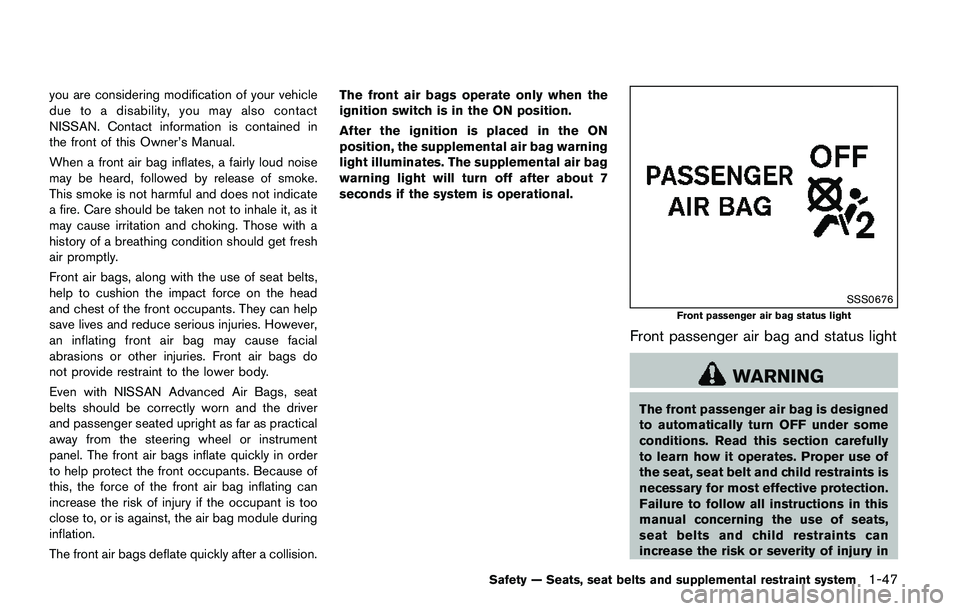
you are considering modification of your vehicle
due to a disability, you may also contact
NISSAN. Contact information is contained in
the front of this Owner’s Manual.
When a front air bag inflates, a fairly loud noise
may be heard, followed by release of smoke.
This smoke is not harmful and does not indicate
a fire. Care should be taken not to inhale it, as it
may cause irritation and choking. Those with a
history of a breathing condition should get fresh
air promptly.
Front air bags, along with the use of seat belts,
help to cushion the impact force on the head
and chest of the front occupants. They can help
save lives and reduce serious injuries. However,
an inflating front air bag may cause facial
abrasions or other injuries. Front air bags do
not provide restraint to the lower body.
Even with NISSAN Advanced Air Bags, seat
belts should be correctly worn and the driver
and passenger seated upright as far as practical
away from the steering wheel or instrument
panel. The front air bags inflate quickly in order
to help protect the front occupants. Because of
this, the force of the front air bag inflating can
increase the risk of injury if the occupant is too
close to, or is against, the air bag module during
inflation.
The front air bags deflate quickly after a collision.The front air bags operate only when the
ignition switch is in the ON position.
After the ignition is placed in the ON
position, the supplemental air bag warning
light illuminates. The supplemental air bag
warning light will turn off after about 7
seconds if the system is operational.
SSS0676
Front passenger air bag status light
Front passenger air bag and status light
WARNING
The front passenger air bag is designed
to automatically turn OFF under some
conditions. Read this section carefully
to learn how it operates. Proper use of
the seat, seat belt and child restraints is
necessary for most effective protection.
Failure to follow all instructions in this
manual concerning the use of seats,
seat belts and child restraints can
increase the risk or severity of injury in
Safety — Seats, seat belts and supplemental restraint system1-47
Page 70 of 508
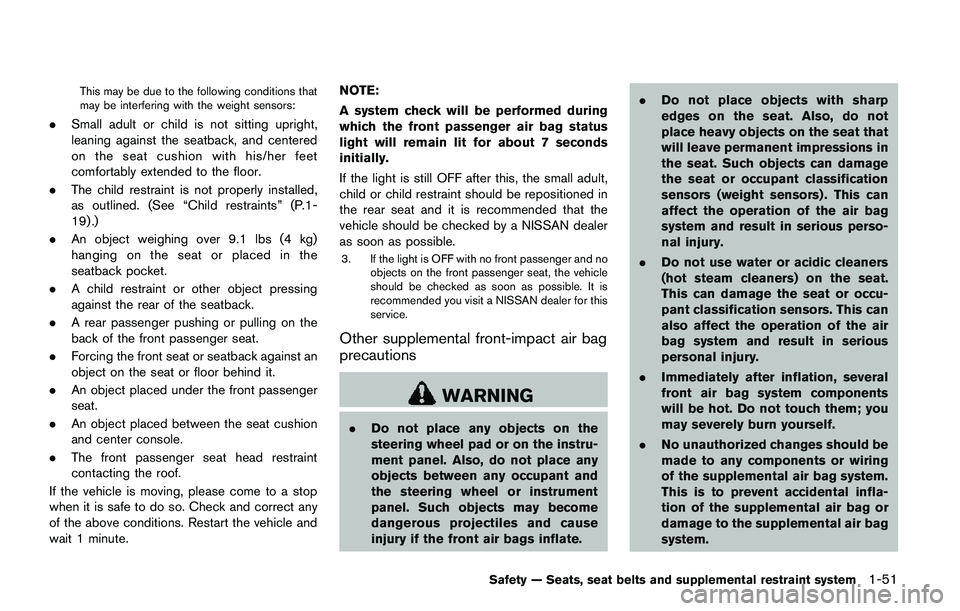
This may be due to the following conditions that
may be interfering with the weight sensors:
.Small adult or child is not sitting upright,
leaning against the seatback, and centered
on the seat cushion with his/her feet
comfortably extended to the floor.
.The child restraint is not properly installed,
as outlined. (See “Child restraints” (P.1-
19) .)
.An object weighing over 9.1 lbs (4 kg)
hanging on the seat or placed in the
seatback pocket.
.A child restraint or other object pressing
against the rear of the seatback.
.A rear passenger pushing or pulling on the
back of the front passenger seat.
.Forcing the front seat or seatback against an
object on the seat or floor behind it.
.An object placed under the front passenger
seat.
.An object placed between the seat cushion
and center console.
.The front passenger seat head restraint
contacting the roof.
If the vehicle is moving, please come to a stop
when it is safe to do so. Check and correct any
of the above conditions. Restart the vehicle and
wait 1 minute.NOTE:
A system check will be performed during
which the front passenger air bag status
light will remain lit for about 7 seconds
initially.
If the light is still OFF after this, the small adult,
child or child restraint should be repositioned in
the rear seat and it is recommended that the
vehicle should be checked by a NISSAN dealer
as soon as possible.
3. If the light is OFF with no front passenger and no
objects on the front passenger seat, the vehicle
should be checked as soon as possible. It is
recommended you visit a NISSAN dealer for this
service.
Other supplemental front-impact air bag
precautions
WARNING
.Do not place any objects on the
steering wheel pad or on the instru-
ment panel. Also, do not place any
objects between any occupant and
the steering wheel or instrument
panel. Such objects may become
dangerous projectiles and cause
injury if the front air bags inflate..Do not place objects with sharp
edges on the seat. Also, do not
place heavy objects on the seat that
will leave permanent impressions in
the seat. Such objects can damage
the seat or occupant classification
sensors (weight sensors) . This can
affect the operation of the air bag
system and result in serious perso-
nal injury.
.Do not use water or acidic cleaners
(hot steam cleaners) on the seat.
This can damage the seat or occu-
pant classification sensors. This can
also affect the operation of the air
bag system and result in serious
personal injury.
.Immediately after inflation, several
front air bag system components
will be hot. Do not touch them; you
may severely burn yourself.
.No unauthorized changes should be
made to any components or wiring
of the supplemental air bag system.
This is to prevent accidental infla-
tion of the supplemental air bag or
damage to the supplemental air bag
system.
Safety — Seats, seat belts and supplemental restraint system1-51
Page 71 of 508
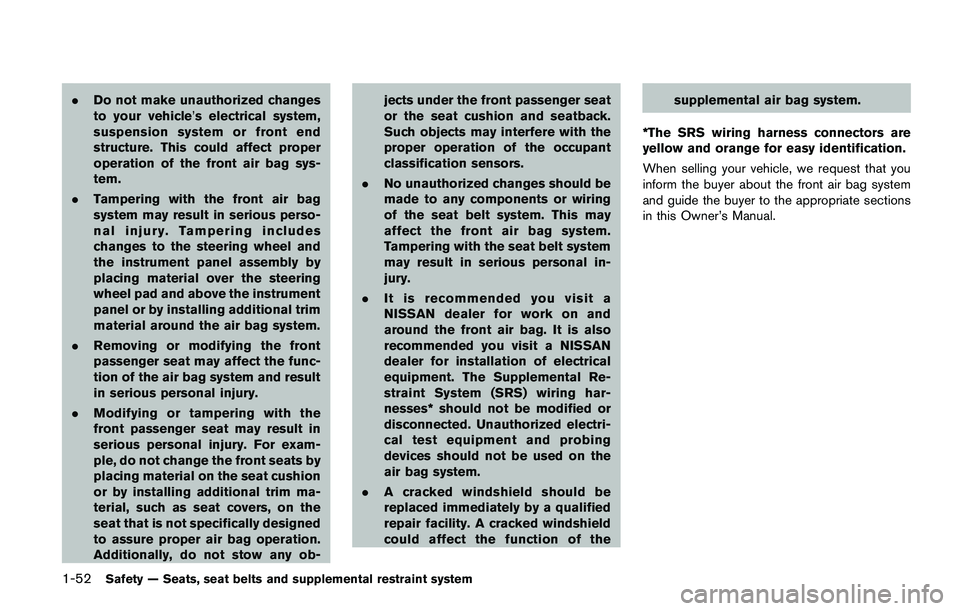
1-52Safety — Seats, seat belts and supplemental restraint system
.Do not make unauthorized changes
to your vehicle’s electrical system,
suspension system or front end
structure. This could affect proper
operation of the front air bag sys-
tem.
.Tampering with the front air bag
system may result in serious perso-
nal injury. Tampering includes
changes to the steering wheel and
the instrument panel assembly by
placing material over the steering
wheel pad and above the instrument
panel or by installing additional trim
material around the air bag system.
.Removing or modifying the front
passenger seat may affect the func-
tion of the air bag system and result
in serious personal injury.
.Modifying or tampering with the
front passenger seat may result in
serious personal injury. For exam-
ple, do not change the front seats by
placing material on the seat cushion
or by installing additional trim ma-
terial, such as seat covers, on the
seat that is not specifically designed
to assure proper air bag operation.
Additionally, do not stow any ob-jects under the front passenger seat
or the seat cushion and seatback.
Such objects may interfere with the
proper operation of the occupant
classification sensors.
.No unauthorized changes should be
made to any components or wiring
of the seat belt system. This may
affect the front air bag system.
Tampering with the seat belt system
may result in serious personal in-
jury.
.It is recommended you visit a
NISSAN dealer for work on and
around the front air bag. It is also
recommended you visit a NISSAN
dealer for installation of electrical
equipment. The Supplemental Re-
straint System (SRS) wiring har-
nesses* should not be modified or
disconnected. Unauthorized electri-
cal test equipment and probing
devices should not be used on the
air bag system.
.A cracked windshield should be
replaced immediately by a qualified
repair facility. A cracked windshield
could affect the function of thesupplemental air bag system.
*The SRS wiring harness connectors are
yellow and orange for easy identification.
When selling your vehicle, we request that you
inform the buyer about the front air bag system
and guide the buyer to the appropriate sections
in this Owner’s Manual.